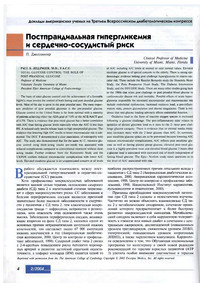Постпрандиальная гипергликемия и сердечно-сосудистый риск
Покупка
Основная коллекция
Тематика:
Эндокринология и болезни обмена веществ
Издательство:
Эндокринологический научный центр
Автор:
Джеллингер П.
Год издания: 2004
Кол-во страниц: 5
Дополнительно
Скопировать запись
Фрагмент текстового слоя документа размещен для индексирующих роботов
Доклады американских ученых на Третьем Всероссийском диабетологическом конгрессе П о с т п р а н д и а л ь н а я г и п е р г л и к е м и я и с е р д е ч н о - с о с у д и с т ы й р и с к П. Джеллингер PAUL S. JELLINGER, M.D., F.A.C.E. TOTAL GLUCOSE CONTROL: THE ROLE OF POST-PRANDIAL GLUCOSE Professor of Medicine Voluntary Faculty University of Miami President Elect American College of Endocrinology The basis of strict glucose control and the achievement of a favorable HgbAlc must involve the control of both fasting and post-prandial glucose levels. Most of the day is spent in the post-prandial state. The most important predictor of post prandial glycemia is the pre-prandial glucose. Glucose control in the United States is far from optimal with a minority of patients achieving either the ADA goal of 7.0% or the ACE/AACE goal of 6.5%. There is evidence that post-meal glucose has a better correlation with A1C than fasting glucose levels especially when the A1C is less than 8%. A reduced early insulin release leads to high postprandial glucose. The evidence that lowering Hgb A1C results in lower microvascular risk is substantial. The DCC T demonstrated a clear association, of retinopathy with A1C . The study also demonstrated that for the same Al C, intensive glucose control using short-acting insulin pre-meals was associated with reduced complications compared to conventional treatment without short acting insulin. Further evidence from the Kumamoto Study and the UKPDS confirm reduced microvascular complications with lower A1C levels. Elevated mealtime glucose is an unappreciated concern at all levels Clinical Professor of Medicine University of Miami, Miami, Florida I of A1C including A1C levels at normal or near normal values. Elevated mealtime glucose is of special concern in the elderly. There is strong epidemiologic evidence linking post challenge hyperglycemia to macro-vascular risk. These include the Rancho Bernardo study the Honolulu Heart Study, the Paris Prospective Heart Study, The Diabetes Intervention Study, and the DECODE Study. There are many other studies going back to the 1980s that relate post-challenge or post-prandial blood glucose to cardiovascular disease risk and mortality. Possible effects of acute hyperglycemia responsible for increased microvascular and macrovascular risk include endothelial dysfunction, increased oxidative load, a pro-inflammatory state, protein glycosylation and altered coagulation. There is evidence that oral glucose loading adversely affects endothelial function. Oxidative load in the form of reactive oxygen species is increased following a glucose challenge. The pro-inflammatory state relates to quintiles of dietary glycemic load as it does to the 2- hour post challenge glucose category. There is evidence that in intimal media thickness increases more with the 2 hour glucose than A 1С. In summary, post mealtime glucose spikes are to be prevented because lowering A1C reduces microvascular complications, A1C reflects post mealtime glucose as well as fasting plasma group glucose, elevated post-meal glucose is a highly prevalent issue and elevated blood glucose 2 hours after a glucose load is associated with increased risk of death independent of fasting blood glucose. The Epic- Norfork study raises questions as to the level of A1C associated with risk. работе обсуждается взаимосвязь между постпрандиальной гипергликемией и сердечно-сосудистым (СС) риском. Хотя профилактика микрососудистых заболеваний является важной целью терапии, осложнения сахарного диабета (СД) типа 2 в значительной степени затрагивают и сферу макрососудистого риска. СС заболевания и болезни периферических сосудов являются причиной значительно более высокой заболеваемости и смертности у пациентов с СД типа 2, чем классическая микрососудистая триада - нефропатия, нейропатия и ретинопатия, хотя опасность этих осложнений также очень высока. Заболевания периферических сосудов, возникающие вторично на фоне СД типа 2, являются одной из основных причин нетравматических ампутаций нижних конечностей, что составляет около 67 ООО ампутаций нижних конечностей в год (Американская диабетическая ассоциация, 2000; Центр по контролю и профилактике заболеваний, 1998). Сахарный диабет типа 2 связан с 2-4-кратным повышением риска патологии коронарных артерий и развития застойной сердечной недостаточности, а инфаркт миокарда (ИМ) является одной из наиболее распространенных причин летального исхода у пациентов с СД типа 2 (Американская диабетическая ассоциация, 2000; Американская кардиологическая ассоциация, 1998; Центр по контролю и профилактике заболеваний, 1998; Национальный Институт кардиологии, пульмонологии и гематологии, 2000). Причины преобладания макрососудистой патологии при СД типа 2 сложны и недостаточно изучены. Частично их можно объяснить взаимосвязью СД типа 2 с метаболическим синдромом, сочетание проявлений которого предрасполагает к более быстрому развитию макрососудистой патологии. Метаболический синдром включает в себя нарушенную толерантность к глюкозе или явный диабет в сочетании с центральным ожирением, дислипидемией (повышенным уровнем триглицеридов, сниженным уровнем ЛПВП; гипертензией; повышенным уровнем атерогенных ЛПНП), а также нарушением коагуляции. Кардиологи осведомлены о том, что Обучающая национальная программа по холестерину в своей новой редакции рекомендаций по терапии взрослых пациентов (АТР 3) уделила особое внимание диагностике и терапии Reprinted with permission from the The American College of Cardiology Copyright © 2002 Excerpta Medica, Inc. All rights reserved.


